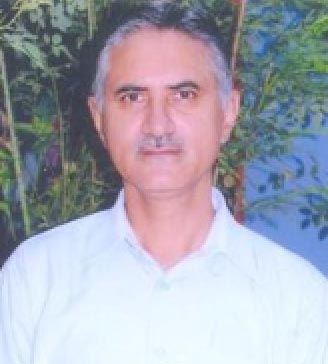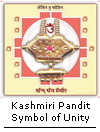Pt. Amar Nath Sapru
immortalised ‘Posh Puza’
By Dr. R.K. Tamiri
'Posha puza'
(floral worship), is the most
important ritual in the marriage ceremony of Kashmiri Pandits. In fact, the
ritual part of the marriage ceremony concludes with 'posha puza'. The couple is
made to sit under the canopy of a red shawl or any other red cloth. Flower
petals are showered on the couple by the parents of the bride. Other close
relations of the bride also join this ceremony. Lately, as an innovation, now
the parents of the bridegroom also participate in this ritual.
'Posha Puza'
among Kashmiri Hindus has
great religious sanctity. Bridegroom and the bride are considered in this ritual
as embodiments of Shiva and Parvati. About 'Posh Puza', Dr Shashi Shekhar
Toshkhani, the distinguished scholar in his treatise ‘Rituals and Ritual Arts
of Kashmir' observes, “The verses recited at this time (during Posh Puza)
refer to the names of gods and goddesses, sages and seers, incarnations,
warriors, famous Kings and queens of the Vedic lore, pious mothers etc., perhaps
to remind them of ideal children like them. ...The bride and the bridegroom are
now blessed wishing them a firm and loving relationship and a long, happy and
prosperous married life”.
The study of
socio-historicity of religious traditions is a fascinating subject. The author
of this essay was amazed when he located ‘Posh Puza’, authored by Pt.
Amar Nath Sapru in the possession of Rawal family of Jammu. It is perhaps the
only work extant which deals with ‘Posh Puza’ in some detail. The book
was published in 1914 at
Sialkot
by Pt. Ravi Narain Handoo (maternal uncle of Cine-Actor AK Hangal), the cousin
of Pt. Amar Nath Sapru. Mothers of Handoo and Sapru were real sisters.
Pt. Amar Nath Sapru:
Pt. Amar Nath Sapru was an
outstandnig scholar with deep insights into Hindu religious traditions and
folk-lore. He knew English, Urdu, Arabic and Persian very well. Subsequently,
after retirement he engaged a teacher for learning Hindi and Sanskrit, when
shifted to Gurukul Kangri,
Hardwar.
He was a Yogi of high order. Despite his appreciation for Arya Samaj tenets, Pt.
Amar Nath Sparu did not renounce Sanatani traditions and was a staunch believer
in Western Kaula rituals. Initially, he loved to take meat, but abandoned it
after he joined Gurukul Kangri.
Pt. Amar Nath Sapru was born
at Sialkot
in 1883 to Pt. Radhakrishan Sapru and Parvati. Radhakrishan Sapru and Allama
Iqbal's grandfather Pt. Kanhaiya Lal Sapru were brothers. Pt. Kanhaiya Lal's son
Ratan Lal was Allama Iqbal’s father. Pt. Amarnath Sapru's mother Parvati was
daughter of renowned Sanskrit teacher of Sialkote, also a Kashmiri, Pt. Damodar
Pandit. The great Sanskrit teacher, departing from tradition, performed the
marriage ceremony of Parvati at the famous shrine of Dhuni Saab
at Qiladar, out of deep reverence for Saint Mansa Ram Razdan. Pt. Damodar
Pandit trained his daughter in religious scriptures and languages. Few could
rival her in recitation of Shiv Mahima Sutr, Indrani Path, Hanuman Chalisa,
Visnu Sahasarnama. She had studied Ramayan, Mahabharat, Yog
Vashishst, Gita, Upanishads. Parvati was also a poet of
some standing and wrote over 80 poems, most of these in Punjabi. Parvati
had also written some poems in Urdu. Perhaps this treasure is lost
forever.
Pt. Amar Nath Sapru derived
his inspiration from his mother. After passing his matriculation he was employed
in the Upper Chenab Circle (Defence Accounts Section) as a clerk. He served in
Sialkot,
Lahore and for sometime in Iran as well. At the age of 18 he married Brij
Kishori, who belonged to Kashmiri family, Thola. They had one daughter Raj
Kishori (b. 1910), who lives in Jammu. Mrs. Brij Kishori died young at the age
of 29 years in 1920.
Pt. Amar Nath's ancestor Pt.
Sahaz Ram Sapru had left Kashmir to settle in Sialkote in 1819. The family had
lot of lands in different parts of Punjab and lived in Mohalla Dharowal
(opposite Bari haveli, near Shivala). Most of the old Kashmiri Pandit
families in undivided
Punjab had lost their language and even some of their religious
traditions. This pained a sensitive intellectual like Pt. Amar Nath Sapru.
Though his ancestors had left
Kashmir a century back, yet Pt. Amar Nath Sapru had deep pride in
his ethnic heritage. To read the poetry of
Kashmir's patron
Saint-poetess Lalleshwari in its original flavour he learnt Kashmiri. Pt. Amar
Nath praised the British scholars for preserving Lalleshwari for posterity. He
was so much enamoured of her philosophy and poetry that he undertook the
difficult task of translating her Vaakhs into Hindi, Urdu and Punjabi.
The translations have been said to be faultless.
‘Posh Puza’ :
Strangely, some of the old
Kashmiri Pandit families under the impact of local cultures, had come to see
‘Posh Puza’ and some other ritual practices as a liability and wastage of
time. ‘Posh Puza’ was often curtailed in order to save time. Others
regarded it as tiresome drudgery. Pt. Janki Nath Kaul, Bar-at-Law and Public
Prosecutor at Sargodha
(1917) even claimed that “Posh Puza” never formed part of true marriage
ceremonies but was imposed by some Pandits at some unknown period. He also
doubted whether ceremony was beneficent in the interest of the married couple or
the ardent listeners of it. But Pt. Janki Nath Kaul admitted, “one thing is
very clear that great interest is evoked in the marriage assembly when this
ceremony is performed. Although this significance is not in the least understood
by those who attend the ceremony”.
These controversies Pt. Amar
Nath Sapru took as a challenge.
At a Christmas function,
organised by Kashmiri Pandit biradari of Lahorein 1914, Pt. Amar Nath strongy
contested those who detested ‘Posh Puza’. He read some “shlokas”
and told them that he would soon come out with a book on ‘Posh Puza’,
detailing its true significance and great usefulness of this most enchanting
episode in the marriage ceremony ritual. He soon, came out with a comprehensive
study on ‘Posh Puza’, dilating on its philosophical importance and
supplied lot of important information with respect to the institution of
marriage.
The book was reviewed by
noted Kashmiri Pandits of Punjab (Letter of Sir Tej Bahadur Sapru enclosed in
the box) in 1917. Pt. Arjan Nath Mattu, Prof. of Sanskrit and English,
Khalsa
College, Amritsar said that the book would help Kashmiri biradari understand the
ethical and philosophical significance of the sacred rite. Pt. Janki Nath Kaul
commented that the translation of the mantras in the book was accurate
and the book was “interesting and instructive”. While commending the book, Pt.
Gopi Nath Sahib, Naib Tehsildar (Muzaffargarh, 1917) hoped that acceptance of
the book by the biradari would enthuse the author to come out with commentaries
on other rituals as well. Pt. Pran Nath Sahib, Deputy Inspector General of
Education Gwalior State said, “I advise your skilful tact in including the
various much needed measures of reform in our community in this pamphlet which
imparts an element of sanctity to them all and this inclines even their
opponents to read what they might leave unread otherwise”. Other leading
Kashmiri Pandits of Punjab e.g. Rajender Prashad Wanchoo, Pleader Muza-ffargarh;
Pt. Shiv Narain Raina, Advocate Chief Court of Punjab (Lahore), Pt. Roop Lal
Razdan of Patiala State, Moshar Nath Sapru of Mohalla Sahaib Ganj (Faizabad),
Pt. Dwarka Nath Razdan ICG Railway Quetta etc. lauded efforts of Pt. Amar Nath
in bringing out this book.
Historicity :
Pt. Brij Nath Sahib also an
expatriate Kashmiri, was spiritual guru of Shri Amar Nath Sapru. ‘Posh Puza’
is dedicated to his memory. Pt. Sapru says ‘Posh Puza’ is a compound
word Posh and Puza; implying puza with flowers. According to him there are no
references as to what time in history this ritual came into existence as part of
marriage ritual (In a related custom, also observed by old Kashmiris, brides are
bedecked with flowers - Phoolon Ka Gahna and a special Puza is
performed). He is of the view that in the marriage ceremony of Lord Rama and
Sita all Brahmins showered coloured flowers on them. Tulsi Das corroborates when
he says :
Padday Veda Muni Mangal Bani
Gaggan Smran Jehri Ausar Jane
(Munis chant mangal charan.
At proper time the coloured flowers are showered on them from sky).
During the ‘Posh Puza’
ceremony specific ‘shlokas’ are chanted, and at the end of each
‘shloka’ flowers are showered on the couple Originally the shlokas
linked to ‘Posh Puza’ were three. Subsequently, three more shlokas were
added to it. Purohits have now included 55 shlokas, which are in no way
relevant to ‘Posh Puza’.
The original six shlokas
(in Sanskrit) are displayed separately. Shri Amarnath Sapru has listed the
shlokas, giving their background and has also included his commentaries
on these. Shloka 1 is a prayer to Brahma, seeking his blessings for
giving wealth, noble ideas and deeds and fame to the couple, besides to help the
couple to have a good child.
In the shloka 2, the
Bridegroom tells the bride to yearn for child only when she attains the child
bearing age. In the 3rd shloka the Bridegroom says to the bride that the
power of procreation is inherent in him only.
‘Vam Marg’:
Pt. Amar Nath Sapru has also
authored a small book titled ‘Kashmiriyon Me Vammarg’ (Left handed ritual
practices). He has given many meanings of ‘Koul’ sect, which follow these
practices. ‘Kouls’ had exalted status among Pandits. There is no unanimity on
the meaning of word ‘Kaula’. According to Pt. Amar Nath Sapru in Sanskrit ‘Kaul’
means a recent creation and a well-considered person. In
Sanskrit Panch Tantra the word has been linked with madira
(wine). Tulsi Das is also of the same view. In the opinion of Pt. AN Sapru the
unique feature in Kaula religious practice is worshipping of Shiva and Shakti
together (shakhta dharma). He observes that ‘Koul’ has originated from
Vedic through a number of steps: Vedic-->visnu-->shiv-->Dakshan-->Vam-->Sidant-->Kaul.
Sapru says that Lord Shiva himself has said to Parvati that no dharma
can equal Kaul dharma. Pt. Amar Nath Sapru claims that word ‘Kaul’ was so
popular in Kashmir that even some rivulets and shrines were named after it -
Sona Kul, Chander Kul, Kuth Kul. Chandra Kaul was dug out by Raja Meher Kaul.
Poetry :
Pt. Amar Nath Sapru was a
good poet too. His entire poetic collection, as per his family, was handed over
to Mr. C.L. Sapru by Pt. AN Sapru himself. He once composed a couplet on a
Vam ritual:
Mera Apna Chota Sa Dar Hai
Madhushala
Sees Me Main Saki Hoon Main
Hi Peene Wala
Sapruji Mera Pandit Man To
Kahta Hai
Chinta Taj Peete Jao
Pyale Par Pyala.
Pt. Amar Nath Sapru was a
rationalist and did not see any conflict between Science and Religion. He had
great sense of humour and loved children. He did not involve himself much in
domestic affairs. Pt. Amar Nath, after his retirement, moved to Gurukul Kangri.
In a rare exception he was
allowed to build a house and have a garden in the campus. During his years here
he taught for a while and helped the management in administrative matters. Dr.
S. Radhakrishan held him in great respect. Pt. Sapru donated his house as well
as his vast collection of books to Gurukul. He died in 1960. His mother Parvati
had also passed away in Gurkul at the age of 97.
Source: Kashmir
Sentinel
| 













No one has commented yet. Be the first!